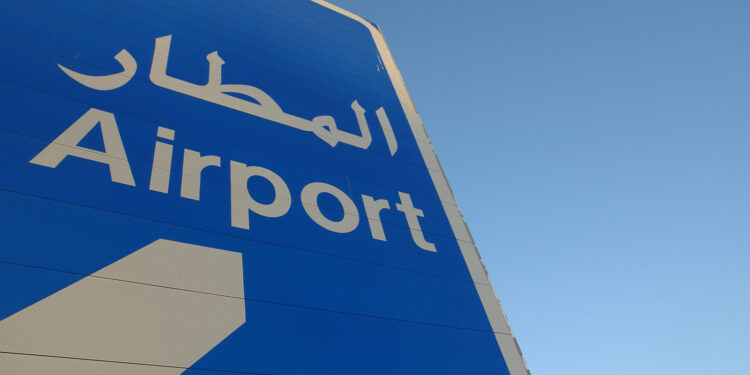10 Popular Airports in the Middle East for Business Aircraft Operators – Part 1 of 2

This business aviation blog post is part one in a series on popular airports in the Middle East for business aircraft operators.
Many good airports for tech stops and overnights are available in the Middle East for business aircraft operators, with 24-hour operations, credit, and full support services. Be mindful of landing and overflight permit and lead time requirements, as well as holiday and weekend schedules, as this will impact your trip planning. Have all required documentation available in the event of a ramp check, along with local sponsor/business contacts as required. Also, be familiar with visa requirements. Best practice is to work with your 3rd-party provider to review all operating restrictions within the region.
Below is an overview of 5 popular airports in the Middle East for business aircraft operators (in no particular order):
1. Istanbul, Turkey (LTFJ)
LTFJ is less restrictive for business aviation operations than Ataturk (LTBA). It’s a frequented destination and effective 24-hour tech stop between Far East/India and Europe. Prior permission required (PPR) is mandatory for all aircraft, with an official lead time of five working days and a minimum of two working days. Airport slots are also required and have a deviation of -10 minutes/+20 minutes. Civil Aviation Authority (CAA) requires the airport slot confirmations to be submitted with your landing permit application. Turkey has specific minimum insurance requirements, which include war-risk liability. One of the inconveniences of operating to LTFJ is that most hotels are located about 28 miles away. Be aware that private non-revenue, charter (non-scheduled commercial) and medevac flights of European Union (EU) registered aircraft with maximum passenger capacity of 12 do not require landing or overflight permits unless flying domestic legs within Turkey or making a technical stop. Full service and credit is available at LTFJ, and major aviation fuel cards are accepted.
2. Dubai, United Arab Emirates (OMDB)
While OMDB is a popular destination, this location is not recommended for tech stops due to airport congestion, taxi delays, and jet fuel truck availability issues. Scheduled commercial flights take priority, particularly during 0800-2200 local peak hours. Landing permits are required with an official lead time of four working days for both private non-revenue and charter flights. Documentation includes airworthiness and registration certificates as well as evidence of worldwide insurance. Airport slots are required and must be requested in a special slot clearance request (SCR) format via slot coordinator. The deviation for these airport slots is -/+ 15 minutes. When submitting airport slot requests, you must provide your assigned aircraft parking stand number. Overflight permits are not needed for the United Arab Emirates (UAE). Passenger visas may be required, so it’s best to check with your 3rd-party provider. Jet fuel services and credit are available, and major aviation fuel cards are accepted. Fueling on arrival is recommended due to likely pre-departure airport congestion.
3. Abu Dhabi Intl, United Arab Emirates (OMAA)
While OMAA is Abu Dhabi’s primary airport for business aviation, you may also consider Bateen (OMAD), a joint military/civilian airport with PPR required. OMAA is a user-friendly airfield with no PPR or airport slot requirements. All services are available 24 hours a day on credit, aviation fuel cards are accepted, and this is a good tech stop. Overflight permits are not required. Always confirm passenger visa requirements with your 3rd-party provider.
4. Riyadh, Saudi Arabia (OERK)
Saudi Arabia requires overflight permits for both private non-revenue and charter flights. The lead time is a minimum of three days, but five days if request is made on the weekend. OERK is an efficient 24-hour airport with tech stop turns in under an hour. Be aware that a business sponsor is required for all operations to Saudi Arabia, and CAA will verify sponsor information. The only exception to this rule is for a tech stop. All services are available on credit and aviation fuel cards are accepted. Jet fuel uplifts should be scheduled in advance, and many operators prefer to fuel on arrival.
5. Jeddah, Saudi Arabia (OEJN)
OEJN is a 24-hour airport used primarily as a destination, but it’s also suitable for tech stops, with a turn time of approximately one hour. Landing permits are required for both private non-revenue and charter flights with a lead-time minimum of three days. If the landing permit request is done on the weekend, a minimum of five days is required. A sponsor is needed for the landing-permit application, and CAA will verify this information. As with OERK, the only exception to this rule is for tech stops only. No PPR or airport slots are required. Saudi Arabia requires overflight permits with a minimum of three working days, but five days are needed if the request is made during the weekend. Full support services and credit are available. Aviation fuel cards are accepted, and best practice is to fuel on arrival.
Conclusion
The Middle East is a straightforward operating environment with reasonable permit lead times. Familiarize yourself with the local culture and customs of the region, dress conservatively, and be aware of local holiday and weekend periods, as weekends differ depending upon the country. Work with your 3rd-party provider to fully understand all local requirements such as business-contact information.
Questions?
If you have any questions about this article, contact me at keithforeman@univ-wea.com.
Later we’ll provide an overview of 5 more popular airports in the Middle East: Sharjah, United Arab Emirates (OMSJ); Bahrain, Bahrain, Kingdom of (OBBI); Doha, Qatar (OTBD); Kuwait, Kuwait (OKBK); and Beirut, Lebanon (OLBA).




